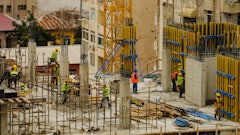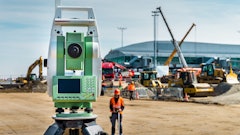
Do we fix it with CPM scheduling tools? Do we need to hire consultants every time a project appears to be at risk of incurring a delay? Or is there a third option - maybe one that involves using automated schedule analytics to avoid future delays. Let’s examine these three approaches and determine their feasibility and likelihood of solving the problem.
Option #1: CPM Scheduling Software
As a scheduler, you are likely familiar with the way CPM scheduling software transformed the construction industry. With scheduling software, a process that had once taken months can now be completed in days. Amazingly, despite clear productivity gains, the industry, in large part, did not advance from a productivity standpoint.
To put a finer point on it, a McKinsey Global Institute report, states that the construction industry “has an intractable productivity problem.” The report goes on to point out the way the manufacturing and retail industries “have transformed themselves and their productive performance” by embracing digital technologies. These two industries are hardly the poster children for technology adoption, but nonetheless, whatever they’re doing appears to be working. In fact, according to the McKinsey report, they are leaps and bounds ahead of construction.
Over the past 10 years, more than 75% of construction companies have grown at a slower rate than the economies in which they work. And as further validation of what I have seen over the past 20 years in the industry, the report goes on to say that “many construction projects suffer from overruns in cost and time,” regardless of whether the companies involved use CPM scheduling software or not. In truth, scheduling software was not designed to solve the issues that plague the construction industry. Scheduling software was originally designed to be a planning tool, one that speeds up the process of building and updating a schedule. As such, it does not check for mistakes, errors, or bad logic. It does not analyze the data to make sure it’s reasonable from a construction standpoint. It simply assumes what is put into the system is accurate and achievable.
However, businesses too often rely on these potentially infeasible, poorly constructed, and sometimes completely unrealistic schedules. To make matters worse, most people can’t tell the difference between a good schedule and a bad schedule as the software does not make the difference between the two readily clear to the businesses that use them.
You may be wondering why the companies making scheduling software don’t just add construction-specific analytics to help their users. Good question. My best answer is that they are not construction tech companies and, therefore, have not invested in the in-house expertise required to do this well. They have built horizontal products they can sell to as many industries as possible for as long as possible. Fixing the construction industry is simply not on their product road maps.
Option #2: Outside Consultants
Given that over 75% of construction projects end in delay or overruns, the inevitable path for most construction projects is one of finger-pointing, blaming, and ultimately, some form of dispute resolution. In fact, a delay is considered so inevitable in the construction industry that most stakeholders have built-in contingency funds earmarked for such occurrences.
In many cases, there are line items in the actual budget for consultants and lawyers – hundreds of thousands of dollars on a medium-sized commercial project. I know this because, for 20 years, construction companies and owners hired me to make sense of, correct, supplement, and analyze project schedules to help them understand where things went off the rails with their projects.
Working with consultants is a long and expensive process, requiring that you take a backward-looking road. As a result, this is not a cost-effective way to run a business or sustain an industry since it lacks the forward-looking capabilities companies need to avoid delays in the future. You would think that with so many construction companies and owners finding themselves on this highly trafficked road, there would be a willingness to try something different. You might be familiar with the saying, , Insanity is doing the same thing over and over and expecting different results.” Yet here we are, still plagued with the same issues. The experts at Freakonomics attribute this industry-wide epidemic to things like planning fallacy, over-optimism, human-driven biases, and fear.
But optimism is human nature, and you can’t blame people for being human. The fact is that starting a new project with an optimistic attitude is a good thing, as long as it’s paired with a sound, risk management process. Blindly planning for best-case scenarios and then hiring consultants to fix expensive, complicated messes when projects inevitably blow up is not a long-term solution. So, what other options do we have?
Option #3: Advance Schedule-Analytics Technology
Given the industry statistics, I think we can all agree that there is a problem. Scheduling programs are not cutting it, and consultants are not a viable solution either. I firmly believe that the only way out of this conundrum is for everyone to have the ability to analyze and understand their schedule data – like an expert consultant, but without being an expert. And technology specifically designed for the unique challenges of the construction industry is the only thing that will get us there.
What are these unique challenges? From my experience,, they can be categorized into four key areas:
The Pace – Construction is a fast-paced industry with lots of moving parts - one that is constantly changing based on multiple activities occurring in tandem. This reality, if not managed effectively via the schedule, can cause a project’s budget and timeline to spiral out of control without anyone realizing it until it’s too late.
The Margins – With such thin margins in the construction industry, making a profit demands tight controls on both time and budget. As a scheduler, you are being asked to do much more with less, directly impacting schedule quality and feasibility.
The People – Most people in the construction industry are optimistic by nature; this is an admirable quality, except in the scheduling process. On the contrary, schedulers need to have their eyes wide open from the start: identifying a variety of possible scenarios, planning for every potential risk, and building schedules that reflect real progress and accurate forecasts. And they can’t give in to the pressures of over-optimism and, in some cases, manipulation.
The Stakeholders – Each construction project has many stakeholders, and each project involves thousands of critical and interrelated activities. At the same time, people within construction have their own businesses to run outside of the project. Managing this reality is difficult and requires regular, dependable, and transparent data analytics.
Welcome to Option #3
Going back to our original premise, the majority of construction projects will incur some delay; whether they are relatively short or long, and whether there is just one or multiple delays, varies from project to project. Barring a miracle from the construction gods, your project will likely fall prey to this industry-wide problem. But it doesn’t have to be that way.
It’s been proven that the most effective way to minimize or even eliminate these delays is by using technology to analyze the schedule. The schedule has a wealth of information regarding a project; in fact, it contains more information than any other single document, all collected in one place. Using the right schedule analysis platform, you can extract the schedule’s “secrets,” laying out in the open all of the potential roadblocks and obstacles for you and your whole team to see.


























